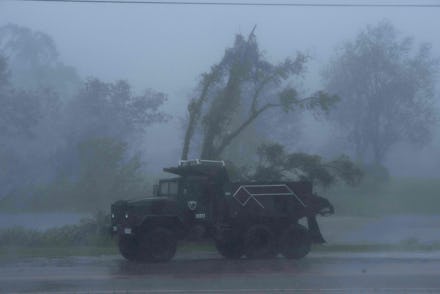Hurricane Ida, supercharged by climate change, was a terrifying preview of the future

Hurricane Ida, a Category 4 storm that rapidly intensified over the weekend, made landfall in the United States on Sunday, bringing with it chaos, devastation, and a reminder that climate change is going to make life hell for the foreseeable future.
Ida was first spotted on Aug. 23 by the National Hurricane Center as a potential tropical cyclone development. By the time it hit the coast of Louisiana on Sunday, making landfall near Port Fourchon at around 11:55 a.m. local time, it was upgraded to a Category 4 hurricane. As the storm left the Gulf of Mexico, it brought with it sustained winds of up to 150 miles per hour and torrential rain. Ida was strong enough to temporarily reverse the flow of the Mississippi River — the result of massive storm surges that rushed massive amounts of water inland, causing flash floods and knocking loose large barges from shore.
To simplify all that, consider this: Hurricane Ida is tied for the strongest on record to ever hit Louisiana as measured by wind force, and is by far the worst hurricane to hit the state since Hurricane Katrina in 2005.
The devastation of this storm says far more than the numbers could. As of Monday morning, more than 1.1 million people were left without power across Louisiana and Mississippi. The entire city of New Orleans was blacked out Sunday night, with only emergency generators left running, as the storm caused "catastrophic transmission damage" to the city's grid. Residents will be in the dark for an undeterminable amount of time as utilities company Entergy struggles to assess the damage and get power back online.
Meanwhile, the record-setting winds that hit the coast ripped the roofs right off of homes and buildings, including hospitals that are attempting to continue operating for those in need of emergency care. Trees have snapped in half and been lifted out of the ground, roots and all. Light poles and power lines have been knocked down, and homes and buildings have been torn to tatters. Knowing just how extensive the damage is at this point is difficult, but it's safe to assume that many people will return to find their homes significantly damaged and potentially unlivable, and their communities in need of rebuilding.
While many people evacuated in the lead up to Hurricane Ida, the storm came so quickly that it was not possible for some to leave. Others simply didn't have the choice — leaving costs money, both to cover the cost of gas and temporary housing out of the path of the storm and in the form of lost wages from missing work.
There has been at least one death reported so far, the apparent result of a tree falling on a home, according to the Associated Press. Rescue efforts are underway for those left trapped by the storm, but Louisiana Gov. John Bel Edwards (D) braced the public for the worst Monday, warning that the death toll for the storm is expected to "go up considerably throughout the day."
While Hurricane Ida appears to have caused less destruction than Hurricane Katrina, and the levees have appeared to hold through the worst of the storm, Ida is still significant — not just because of the damage done, but because of how it formed. Its rapid and dramatic intensification, escalating from a Category 2 to a Category 4 storm in under 24 hours, is a reminder that climate change makes hurricanes and other storms more dangerous. Temperatures in the Gulf of Mexico are three to five degrees Fahrenheit higher than they were two decades ago, and that additional heat makes storms like Ida stronger.
In fact, Hurricane Ida tied or set records for hurricane strength that haven't been broken since the 1850s. And the next record storm likely won't wait 150 years before it shows up.